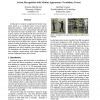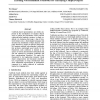402 search results - page 10 / 81 » Feature Generation for Sequence Categorization |
IROS
2006
IEEE
14 years 1 months ago
2006
IEEE
— A planning method for unraveling deformable linear objects based on 2D information about their crossing states is proposed. In manipulation of a linear object, its raveling mus...
TOG
2008
13 years 7 months ago
2008
A semi-automatic approach is presented that enables the generation of a high-quality 3D model of a static object from an image sequence that was taken by a moving, uncalibrated co...
ACHI
2009
IEEE
14 years 2 months ago
2009
IEEE
Designing CSCW systems that support the widely varying needs of targeted users is difficult. There is no silver bullet technology that enables users to effectively collaborate wit...
CVPR
2008
IEEE
14 years 2 months ago
2008
IEEE
In this paper we propose an approach for action recognition based on a vocabulary forest of local motionappearance features. Large numbers of features with associated motion vecto...
ICML
2009
IEEE
14 years 8 months ago
2009
IEEE
Codebook-based representations are widely employed in the classification of complex objects such as images and documents. Most previous codebook-based methods construct a single c...


